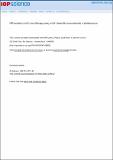Files in this item
NIR-assisted orchid virus therapy using urchin bimetallic nanomaterials in phalaenopsis
Item metadata
| dc.contributor.author | Chen, Shin-Yu | |
| dc.contributor.author | Cheng, Liang-Chien | |
| dc.contributor.author | Chen, Chien-Wei | |
| dc.contributor.author | Lee, Po-Han | |
| dc.contributor.author | Yu, Fengjiao | |
| dc.contributor.author | Zhou, Wuzong | |
| dc.contributor.author | Liu, Ru-Shi | |
| dc.contributor.author | Do, Yi-Yin | |
| dc.contributor.author | Huang, Pung-Ling | |
| dc.date.accessioned | 2014-11-20T12:31:04Z | |
| dc.date.available | 2014-11-20T12:31:04Z | |
| dc.date.issued | 2013-08-14 | |
| dc.identifier | 95678345 | |
| dc.identifier | 08ee12d9-73af-46fa-aae7-083487ddf3b2 | |
| dc.identifier | 84894224374 | |
| dc.identifier.citation | Chen , S-Y , Cheng , L-C , Chen , C-W , Lee , P-H , Yu , F , Zhou , W , Liu , R-S , Do , Y-Y & Huang , P-L 2013 , ' NIR-assisted orchid virus therapy using urchin bimetallic nanomaterials in phalaenopsis ' , Advances in Natural Sciences: Nanoscience and Nanotechnology , vol. 4 , 045006 . https://doi.org/10.1088/2043-6262/4/4/045006 | en |
| dc.identifier.issn | 2043-6262 | |
| dc.identifier.other | ORCID: /0000-0001-9752-7076/work/58055027 | |
| dc.identifier.uri | https://hdl.handle.net/10023/5818 | |
| dc.description | The authors would like to thank the Council of Agriculture (grant number 101AS-9.1.1-FD-Z1) of Taiwan and National Science Council (contracts numbers NSC 101-2113-M-002-014-MY3 and NSC 101-3113-P-002-021) for financially supporting this research. | en |
| dc.description.abstract | The use of nanoparticles has drawn special attention, particularly in the treatment of plant diseases. Cymbidium mosaic virus (CymMV) and Odontoglossum ring spot virus (ORSV) are the most prevalent and serious diseases that affect the development of the orchid industry. In this study we treated nanoparticles as a strategy for enhancing the resistance of orchids against CymMV and ORSV. After chitosan-modified gold nanoparticles (Au NPs) were injected into Phalaenopsis leaves, the injected leaves were exposed to 980 nm laser for light–heat conversion. To evaluate virus elimination in the treated Phalaenopsis leaves, the transcripts of coat protein genes and the production of viral proteins were assessed by reverse transcription-Polymerase chain reaction and enzyme-linked immunosorbent assay, respectively. The expression of coat protein genes for both CymMV and ORSV was significantly lower in the chitosan-modified Au NP-treated Phalaenopsis leaves than in the control. Similarly, the amount of coat proteins for both viruses in the Phalaenopsis leaves was lower than that in the control (without nanoparticle injection). We propose that the temperature increase in the chitosan-modified Au NP-treated Phalaenopsis tissues after laser exposure reduces the viral population, consequently conferring resistance against CymMV and ORSV. Our findings suggest that the application of chitosan-modified Au NPs is a promising new strategy for orchid virus therapy. | |
| dc.format.extent | 7 | |
| dc.format.extent | 1350626 | |
| dc.language.iso | eng | |
| dc.relation.ispartof | Advances in Natural Sciences: Nanoscience and Nanotechnology | en |
| dc.subject | QD Chemistry | en |
| dc.subject.lcc | QD | en |
| dc.title | NIR-assisted orchid virus therapy using urchin bimetallic nanomaterials in phalaenopsis | en |
| dc.type | Journal article | en |
| dc.contributor.institution | University of St Andrews. School of Chemistry | en |
| dc.contributor.institution | University of St Andrews. EaSTCHEM | en |
| dc.identifier.doi | https://doi.org/10.1088/2043-6262/4/4/045006 | |
| dc.description.status | Peer reviewed | en |
This item appears in the following Collection(s)
Items in the St Andrews Research Repository are protected by copyright, with all rights reserved, unless otherwise indicated.

